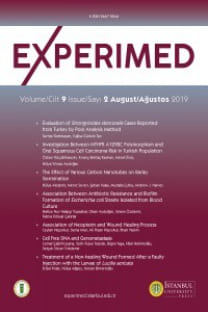Ağır Malnutrisyon Nadir Bir Sebebi Olarak Smith Lemli Opitz Sendromu
DOI: 10.26650/experimed.2018.430582Ağır malnutrisyon etiolojisinde kolesterol sentez bozukluklarından biri olan Smith Lemli Opitz (SLOS) klasik ayırıcı tanı şemalarında yer almamaktadır. Dikkatli fizik muayene ile ipuçları yakalanabilen bu hastalığa malnutrisyon etiolojisinde dikkat çekmek için bu olgu seçilmiştir. Akrabalığı olmayan ailenin ilki abortus 2. gebeliğinden yaşayan tek çocuk olan kız hasta kilo alamama şikayeti ile 4 aylık ağır akut malnutrisyon tanısı ile polikliniğimize yönlendirilmişti. Fizik muayenede tartı, boy, baş çevresi 3. persentil ve altında olup, ayak 2-3. parmak arası sindaktilisi, dismorfik yüz görünümü mevcuttu. Nöromotor gelişimi yaşına uygundu. Fenotipten şüphelenilerek istenen lipid analizinde hipolipidemi olduğu görüldü. SLOS ayırıcı tanıda düşünülüp biyomarkerı 7 dehidrokolesterol (7DHK) istendi. 7DHK düzeyi 1772 ( n<10 mmol/L) yüksek saptanıp; moleküler tetkikle p.Tyr432cys (c.1295 A>G) htr p.Arg446Trp(c.1336C>T) heterozigot mutasyonu tespit edildi. Hastanın steriod hormonları, safra asidi sentezi, yağda eriyen vitamin emilimi, merkezi sinir sistemi gelişimi etkilenebileceği için ayrıntılı değerlendirildi. Patent foramen ovale dışında patoloji saptanmadı. Tedavide safra asidleri (ursodeoksikolik asid 15-25 mg/kg/gün), kolesterol (50-100 mg/kg/gün) yerine koyma tedavisi başlandı. Diyet kolesterolden zengin olarak düzenlendi. 1 ay sonra Tartı: 5935 g, boy: 69 cm, baş çevresi: 38 cm, total kolesterol: 83mg/dL, HDL: 30mg/dL, LDL: 32mg/dL, bulundu. Hastanın besin tüketiminin yeterli olmadığı öğrenildi. Perkütan endoskopik gastrostomi enteral beslenmeye geçildikten sonra kilo ve kolesterol düzeyleri düzeldi. Smith Lemli Opitz tanısı için tam fizik muayene yapılarak, çorapları çıkarmak parmak yapısına bakmak, uvulayı kontrol edip bifid uvula aramak gibi ayrıntıya dikkat etmek gerekir. Malnutrisyon rutin tetkikleri arasında trigliserid, kolesterol kontrolü yoktur. Dismorfik malnutrisyonlu hastalarda lipid profili kontrolü unutulmamalıdır.
Anahtar Kelimeler:
Smith Lemli Opitz, dislipidemi, malnutrisyon, dismorfi, sindaktili
Smith–Lemli–Opitz Syndrome: A Rare Cause of Severe Malnutrition
DOI: 10.26650/experimed.2018.430582Smith–Lemli–Opitz syndrome (SLOS) is a cholesterol synthesis disorder, with an etiology of severe malnutrition, which is often excluded from typical differential diagnostic strategies. However, SLOS can be detected during a careful physical examination; thus, it was selected to draw attention to the malnutrition etiology.It was selected to exemplify how an inborn error in cholesterol metabolism can induce malnutrition. A four month old girl was referred to our polyclinic with a diagnosis of severe acute malnutrition since 4 months. She was the only child from a second pregnancy; the first child of her non-consanguineous parents was lost due to an abortion. Physical examination involving weight, height, and head circumference were at third centimeter persentile and below; additionally, dysmorphic facial appearance and syndactyly between the second and third finger of the foot feet was noted. Neuromotor development was normal for her age. Suspecting a phenotype suggesting a congenital problem, a lipid analysis was performed that revealed hypolipidemia. SLOS was considered as a differential diagnosis. Accordingly, the level of biomarker 7 dehydrocholesterol was assessed controlled and was found to be 1772, which was considerably higher than normal (normal < 10 mmol/L). Subsequently, molecular assay revealed pTyr432Cys (c.1295A> G) htr pArg446Trp (c.1336C> T) heterozygous mutation. Steroid hormone levels, bile acid synthesis, fat-soluble vitamin absorption, and central nervous system development may be negatively affected because they were evaluated in detail. No other pathology was detected except for a patent foramen ovale. A replacement therapy comprising of bile acids (ursodeoxycholic acid 15–25 mg/kg/day) and cholesterol (50–100 mg/kg/day) was initiated, along with a cholesterol-rich diet. After 1 month, the patient weighed 5935 g, with a height of 69 cm, head circumference of 38 cm, total cholesterol level of 83 mg/dL, High density lipoprotein (HDL) level of 30 mg/dL, and Low density lipoprotein (LDL) level of 32 mg/dL. However, the patient’s nutrient intake was not adequate, and percutaneous endoscopic gastrostomy was initiated, following which the patient’s weight and cholesterol levels improved. To reach SLOS diagnosis, it is necessary to conduct full physical examination, including taking out the socks; looking at toe finger structure; evaluating head size, palate, uvula, and external genitals; and observing signs of mental retardation. In routine tests for assessing malnutrition, triglyceride and cholesterol control are not performedassesed. The evaluation of the serum lipid profile should not be overlooked in patients with dysmorphic malnutrition.
Keywords:
Smith-Lemli-Opitz Syndrome, dyslipidemia, malnutrition, dysmorphic, syndactyly,
___
- Alberda, C., Graf, A., McCargar, L., 2006. Malnutrition: Etiology, consequences, and assessment of a patient at risk. Best Pract. Res. Clin. Gastroent. 20, 419–439.
- Mitsche, M.A., McDonald, J.G., Hobbs, H.H., Cohen, J.C., 2015. Flux analysis of cholesterol biosynthesis in vivo reveals multiple tissue and cell-type specific pathways. eLife. 4,1-21.
- Xu, L. ve Porter, N.A., 2015. Free radical oxidation of cholesterol and its precursors: Implications in cholesterol biosynthesis disorders. Free Radic Res. 49, 835–849.
- Boland, M.R. ve Tatonetti, N.P., 2016. Investigation of 7-dehydrocholesterol reductase pathway to elucidate off-target prenatal effects of pharmaceuticals: a systematic review. Pharmacogenomics J. 16, 411–429.
- Slominski, A.T., Li, W., Kim T.K., Semak, I., Wang, J., Zjawiony, J.K., Tuckey,R. C., 2015. Novel activities of CYP11A1 and their potential physiological significance. J Steroid Biochem Mol Biol. 151, 25–37.
- Nowaczyk, M. J.M. ve Irons, M.B., 2012. Smith–Lemli–Opitz Syndrome: Phenotype, Natural History, and Epidemiology. Am. J. Med. Gen. 160C,250–262.
- Porter, F.D., 2008. Smith–Lemli–Opitz syndrome: pathogenesis, diagnosis and management Eur. J. Hum. Gen. 16, 535–541.
- Yayın Aralığı: Yılda 3 Sayı
- Başlangıç: 2011
- Yayıncı: İstanbul Üniversitesi
Sayıdaki Diğer Makaleler
Recai TÜRKOĞLU, Canan ULUSOY, Vuslat YILMAZ
Gülşen ALTINKANAT GELMEZ, Güner SÖYLETİR
Cihan COŞKUN, Alev KURAL, Macit KOLDAŞ
Ağır Malnutrisyon Nadir Bir Sebebi Olarak Smith Lemli Opitz Sendromu
Tuncay GÜNDÜZ, Tuba TANYEL KİREMİTÇİ, Canan ULUSOY, Murat KÜRTÜNCÜ, Recai TÜRKOĞLU
Bir Olgu Nedeniyle Doğumsal Metabolik Hastalıklara Bağlı Parmak Ucunda Yürüme
